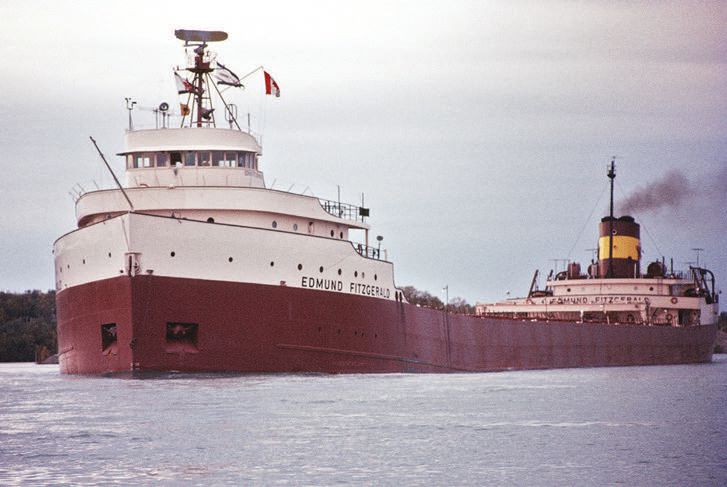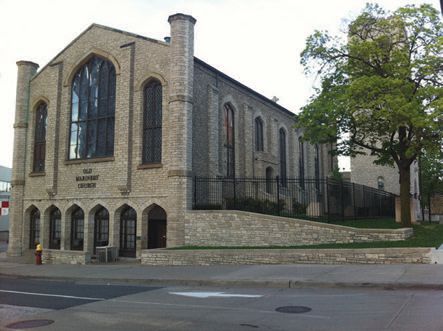Gales of November
Evan Zabawski | TLT From the Editor November 2015
Immortalized in song, the Edmund Fitzgerald demonstrates the importance of postmortem investigations.

“THE LEGEND LIVES ON FROM THE CHIPPEWA ON DOWN“ were the words that entered my mind as I left the GM Renaissance Center during a break at the 2013 STLE Annual Meeting & Exhibition in Detroit. What prompted this, along with thoughts of reliability centered maintenance (RCM), was the sight of a beautiful old stone building across the street: the Mariners’ Church of Detroit, which I immediately recognized as the incorrectly named Maritime Sailors’ Cathedral from Gordon Lightfoot’s iconic song The Wreck of the Edmund Fitzgerald.
I have always enjoyed the song and have long been interested in the unsolved mystery of the Nov. 10, 1975, sinking. With great curiosity I read Joseph MacInnis’ book Fitzgerald’s Storm, based on dives he made to the wreck site nearly 30 years after the sinking, but he could not identify a cause. On the other hand, his book did point out other artistic liberties Gordon Lightfoot took in his retelling.
It is only fair to mention that Lightfoot did struggle to write the song over fear of possible inaccuracies until his producer encouraged him to “just tell a story.” Working from a Newsweek article, The Cruelest Month, by James R. Gaines published two weeks after the sinking, he crafted his ballad using the structure from an old Scottish folk tune. Obviously it worked; the song hit No. 1 in Canada and No. 2 on the Billboard Hot 100.
Besides altering the name of the church and calling it musty (later changed to rustic), Lightfoot changed the ship’s destination from Detroit to Cleveland to make a better rhyme. The dialogue from the cook is purely conjecture in the passage, “When suppertime came the old cook came on deck sayin’, ‘Fellas, it’s too rough t’feed ya.’ At seven p.m. a main hatchway caved in; he said, ‘Fellas, it’s bin good t’know ya!’”
 The sight of a beautiful, old stone building prompted thoughts of reliability centered maintenance.
The sight of a beautiful, old stone building prompted thoughts of reliability centered maintenance.
A greater issue within that passage is the implication that the hatches were not secured properly. This distressed Ruth Hudson, mother of 22-year-old Brian Hudson, one of the deck hands whose job would have been checking the hatches. Only the facts that the ship sank so quickly that no one survived—and the wreckage surveyed days later showing the ship broke in two—suggested this could be a cause.
Four subsequent expeditions in 1976, 1980, 1989 and 1994 (by MacInnis) could not determine a conclusive cause. A separate expedition in 1994 located one crew member wearing a life jacket near the bow, prompting belief that at least some of the crew were aware the ship was sinking, and therefore the ship must have broken up on the surface before sinking.
People unattached to a tragedy often question why so much effort over such a long period of time is put into determining the root cause of an accident. The answer is the foundation of RCM: to take measures to prevent a similar failure from occurring again. If the hatch closure design was found to be ineffective, or if an insufficient number of closures were employed, then changes in design or policy could be enforced.
If the cause was something like a rogue wave (a group of three was reported in the area at the time of sinking) or poor weather, then improved tide monitoring or quicker safe anchorage orders from the Coast Guard could be instituted (one was broadcast approximately 3.5 hours before the sinking but hours after the gale was upgraded to storm).
In 2010 the crew was finally vindicated; another investigation could not find sufficient evidence that the hatches were not sealed, but using a wave simulator on a model compelling evidence showed that a rogue wave was the likeliest cause. Upon hearing the news Lightfoot agreed to update his lyrics, eventually settling on, “At seven p.m. it grew dark, it was then he said.”
As we honor the 40th anniversary of the sinking this month, we can reflect that 35 years of effort brought closure and redemption “for each man on the Edmund Fitzgerald.”
 Evan Zabawski, CLS, is a business development/reliability specialist for ALS Tribology in Calgary, Alberta, Canada. You can reach him at evan.zabawski@alsglobal.com
Evan Zabawski, CLS, is a business development/reliability specialist for ALS Tribology in Calgary, Alberta, Canada. You can reach him at evan.zabawski@alsglobal.com.